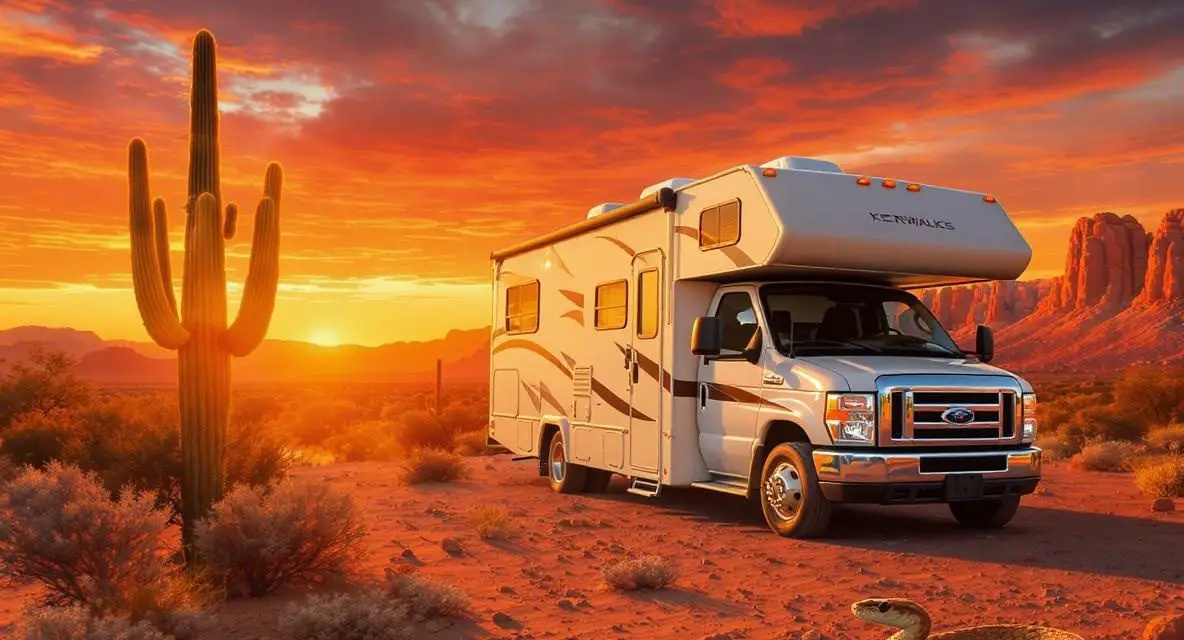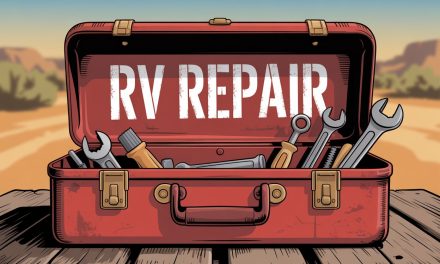Would you like to save this article?
You’re living your best RV life in the beautiful Arizona desert when suddenly your worst camping nightmare becomes reality. That’s exactly what happened to this nomadic RV traveler in Quartzsite, Arizona, and his terrifying encounter will make you think twice about desert boondocking.
When you’re out there with your furry companions, enjoying the freedom of the open road, the last thing you expect is to find a deadly rattlesnake sunbathing right in your campsite.
This real-life encounter captured on camera shows us exactly why desert RV camping requires constant vigilance and respect for the wildlife that calls these places home. Get ready for a wild ride through the seven most frightening moments that unfold when rattlesnakes decide to crash your camping party!
1. The Heart-Stopping Moment of Discovery
The most terrifying part of any rattlesnake encounter is that split second when your brain processes what you’re looking at. In this chilling footage, our RV nomad was simply walking his dogs out for their evening routine when he spotted something that made his blood run cold. The snake was lying completely motionless, flattened out to absorb maximum sun exposure, making it nearly invisible against the desert floor.
Key Statistics:
- According to the U.S. Food and Drug Administration, approximately 8,000 people encounter venomous snake bites every year
- Only 10-15 of these encounters result in death annually
- Peak rattlesnake activity occurs from April through October in desert regions
What makes this discovery particularly nerve-wracking is the timing. You’re in your routine, your guard is down, and suddenly you’re face-to-face with one of nature’s most efficient predators. The YouTuber’s heavy breathing and obvious panic in the video shows just how shocking these encounters can be, even for experienced desert campers.
2. Your Dogs Become Walking Targets
Perhaps the most gut-wrenching aspect of finding a rattlesnake in your campsite is realizing your beloved pets are in mortal danger. Dogs are naturally curious creatures, and their instinct to investigate interesting smells can be deadly in rattlesnake territory. The video shows how quickly the situation becomes about protecting vulnerable four-legged family members who don’t understand the danger.
Frightening Facts About Pets and Rattlesnakes:
- Dogs are 25 times more likely to die from rattlesnake bites than humans
- Most pet rattlesnake bites occur on the face or legs
- Treatment for a dog’s rattlesnake bite can cost $3,000-$5,000
Here’s what’s really scary: Even well-trained dogs might not recognize the threat fast enough. The nomad in the video mentions how his dogs, Echo and Dodger, are usually good listeners, but all it takes is one curious sniff for disaster to strike. The constant worry about your pets’ safety transforms what should be a relaxing camping experience into a nerve-wracking vigil.
3. Your Safe Space Becomes a Danger Zone
The psychological impact of finding a rattlesnake in your campsite is devastating because it completely destroys your sense of security. This isn’t just any snake encounter – this is happening in what you consider your temporary home territory. The video captures this emotional trauma perfectly as the camper realizes that the area where he walks multiple times daily has become a potential death trap.
Desert Camping Reality Check:
- Quartzsite, Arizona hosts over 1 million visitors during peak season
- The Sonoran Desert is home to 13 different rattlesnake species
- Rattlesnakes can strike up to 2/3 of their body length
The truly unnerving part is how this changes everything. Every step outside your RV becomes calculated. Every shadow could be hiding danger. The simple act of taking your dogs out for a bathroom break transforms into a high-stakes reconnaissance mission. The peace and freedom that drew you to desert camping in the first place gets replaced by constant hypervigilance.
4. The Nighttime Horror Show
One of the most chilling revelations in the video is when the camper realizes that rattlesnakes are primarily nocturnal hunters. This means that the snake basking in his campsite during the day will likely be actively moving around at night – right when you need to take those late-night bathroom breaks or let your dogs outside.
Terrifying Nocturnal Snake Facts:
- Rattlesnakes hunt primarily at night when temperatures are cooler
- They can detect heat signatures from warm-blooded animals up to several feet away
- Desert rattlesnakes often seek shelter under RVs and camping equipment
Imagine this scenario: It’s 2 AM, your dog needs to go outside, and you’re stumbling around in the dark knowing there’s a venomous snake somewhere in your immediate vicinity. The video shows our camper had exactly this experience the night before discovering the snake, walking his dog Dodger outside in complete darkness. The thought of what could have happened sends chills down your spine.
5. Your Campsite Becomes a Snake Sanctuary
What makes rattlesnake encounters particularly horrifying for RV campers is the realization that your campsite might be providing the perfect habitat for these dangerous creatures. The video reveals how the snake had likely been living in the area for some time, not just passing through. Desert camping areas often have the ideal combination of shelter, food sources, and temperature regulation that rattlesnakes love.
Why RV Campsites Attract Rattlesnakes:
| Attraction Factor | Why Snakes Love It |
|---|---|
| Packrats/Mice | Primary food source attracted to campsites |
| Shade Under RVs | Perfect temperature regulation |
| Rock Piles | Ideal hiding spots and dens |
| Water Sources | Essential for survival |
| Minimal Human Traffic | Less disturbance in boondocking areas |
The most disturbing realization is that your presence might actually be making the problem worse. Food scraps, pet food, and water sources can attract rodents, which in turn attract rattlesnakes. You’re essentially creating a dinner invitation for one of the desert’s most dangerous predators.
6. The Impossible Decision: Stay or Go?
The video captures one of the most agonizing aspects of discovering a rattlesnake in your campsite – the impossible decision of what to do next. Do you pack up and leave immediately? Do you try to wait it out? Do you attempt to remove the snake yourself? Each option comes with its own set of terrifying implications.
Your Terrible Options:
- Waiting it out: The snake might return every day (they’re territorial)
- Trying to remove it: Extremely dangerous without proper training
- Calling authorities: Limited options in remote desert locations
- Packing up immediately: Disrupts your entire travel plans
What makes this decision so nerve-wracking is the uncertainty. As shown in the video, the camper is torn between his love for the location and the very real danger to himself and his pets. The snake has essentially taken hostage what was supposed to be a peaceful desert retreat. Every minute you delay the decision, the anxiety builds.
7. The Paranoia That Never Ends
Perhaps the most psychologically damaging aspect of a rattlesnake encounter is how it permanently changes your camping experience. The video shows how every sound, every shadow, every movement becomes suspect. What was once a relaxing connection with nature becomes a constant state of alertness and fear.
Long-term Psychological Impact:
- Hypervigilance during all outdoor activities
- Constant worry about pet safety
- Disrupted sleep patterns
- Reduced enjoyment of desert camping
- Persistent anxiety about future encounters
The camper in the video perfectly describes this transformation. He mentions how he’ll now need to keep his dogs on leashes constantly and change their hiking patterns. The freedom and spontaneity that makes RV nomad life so appealing gets replaced by rigid safety protocols and endless worry. Even after leaving the area, the memory of that rattlesnake will haunt future camping decisions.
Safety Statistics That Will Keep You Up at Night
According to rattlesnake safety experts, desert camping incidents are more common than most people realize:
- 5-6 deaths per year occur from rattlesnake bites in the U.S.
- Late October is peak season for rattlesnake encounters
- Most bites happen within 50 feet of the victim’s campsite
- Arizona leads the nation in rattlesnake bite incidents
The reality is that if you’re camping in rattlesnake habitat, encounters are not a matter of “if” but “when.” This video serves as a crucial reminder that desert beauty comes with very real dangers.
SOURCES
- RV Life – What You Need To Know About The Dangers Of Rattlesnakes
- Rivers and RV Resort – Staying Safe in Quartzsite’s Desert
- Roadtrippers – The Camper’s Guide to Snake Safety
- Got Out YouTube Channel – Original Video
- National Park Service – Rattlesnake Safety
- RV Travel – Animals in the Southwest






